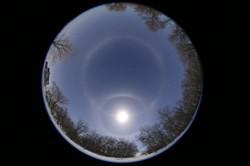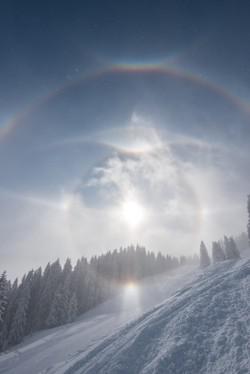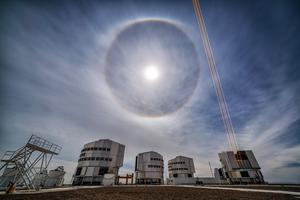Glossary term: Halo
Description: Un halo est un phénomène optique causé par des cristaux de glace dans l'atmosphère terrestre. Tout comme la réfraction et la réflexion dans les gouttelettes d'eau provoquent des arcs-en-ciel, la lumière du soleil traversant les cristaux de glace est réfléchie et réfractée à l'intérieur de ceux-ci pour former des halos. Les halos peuvent prendre différentes formes et être causés par la lumière du Soleil ou de la Lune. Le halo de 22 degrés est un halo circulaire qui se forme comme une fine bande de lumière autour du Soleil ou de la Lune. La géométrie de ce halo est le résultat des propriétés des cristaux de glace que la lumière du soleil ou de la lune traverse dans l'atmosphère.
Le mot halo est également utilisé dans d'autres contextes astronomiques, notamment : halo galactique, halo de matière noire et halo stellaire, qui sont tous des composants majeurs de la structure des galaxies.
Related Terms:
See this term in other languages
Term and definition status: The original definition of this term in English have been approved by a research astronomer and a teacher The translation of this term and its definition is still awaiting approval
The OAE Multilingual Glossary is a project of the IAU Office of Astronomy for Education (OAE) in collaboration with the IAU Office of Astronomy Outreach (OAO). The terms and definitions were chosen, written and reviewed by a collective effort from the OAE, the OAE Centers and Nodes, the OAE National Astronomy Education Coordinators (NAECs) and other volunteers. You can find a full list of credits here. All glossary terms and their definitions are released under a Creative Commons CC BY-4.0 license and should be credited to "IAU OAE".
Related Media
Selene meets the Moon, by Sheila Wiwchar, Canada
Credit: Sheila Wiwchar/IAU OAE
License: CC-BY-4.0 Creative Commons Attribution 4.0 International (CC BY 4.0) icons
Winter Haloes, by Thomas Gigl, Germany
Credit: Thomas Gigl/IAU OAE
License: CC-BY-4.0 Creative Commons Attribution 4.0 International (CC BY 4.0) icons
ESO's Very Large Telescope (VLT) at Paranal Observatory with a lunar halo
Credit: Juan Carlos Muñoz-Mateos/ESO credit link
License: CC-BY-4.0 Creative Commons Attribution 4.0 International (CC BY 4.0) icons
Lunar rainbow and lunar Brocken spectre, by Kouji Ohnishi, Japan
Credit: Kouji Ohnishi/IAU OAE
License: CC-BY-4.0 Creative Commons Attribution 4.0 International (CC BY 4.0) icons












